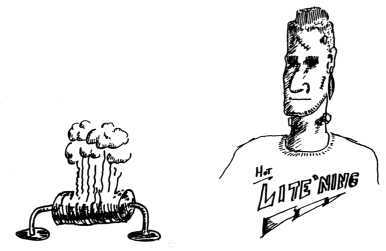
Before continuing on to diodes, transistors, and the other
solid-state components, there is one other item we should consider. As we've
already seen, resistors are measured in Ohms, capacitors in Farads, and
inductors in Henries. But each of these has another rating too, which relates to
how much electricity they can handle before blowing up or melting.
If you've ever watched a Frankenstein movie, you must realize that whenever a voltage gets beyond a certain level, it will jump through the air to get to the other contact. In fact, this is precisely what makes lightning jump from the sky to the earth. The same thing happens with a capacitor when its voltage rating is exceeded. Of course this will be on a much smaller scale, but the effect is the same.
Though some type of insulation is placed between the metal plates of every capacitor, if too much voltage is applied the insulation will become punctured rendering it useless. Therefore, besides the usual measure of its capacitance, all capacitors have a maximum voltage rating as well.
Resistors and inductors can also be damaged, though in this case by applying too much current. Just as trying to force too much water through a pipe will cause it to rupture, the same thing can happen to a resistor or inductor. There are formulas that tell how much current and voltage is allowable for any given circuit, though we won't bother with them here. It's really just the concepts that are important.